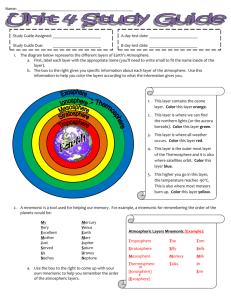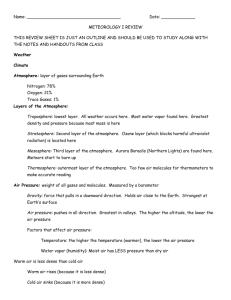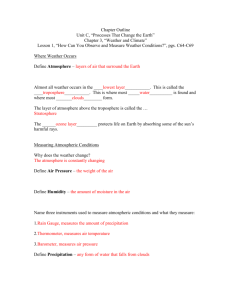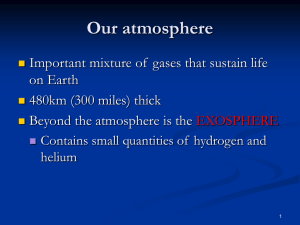the atmosphere
advertisement
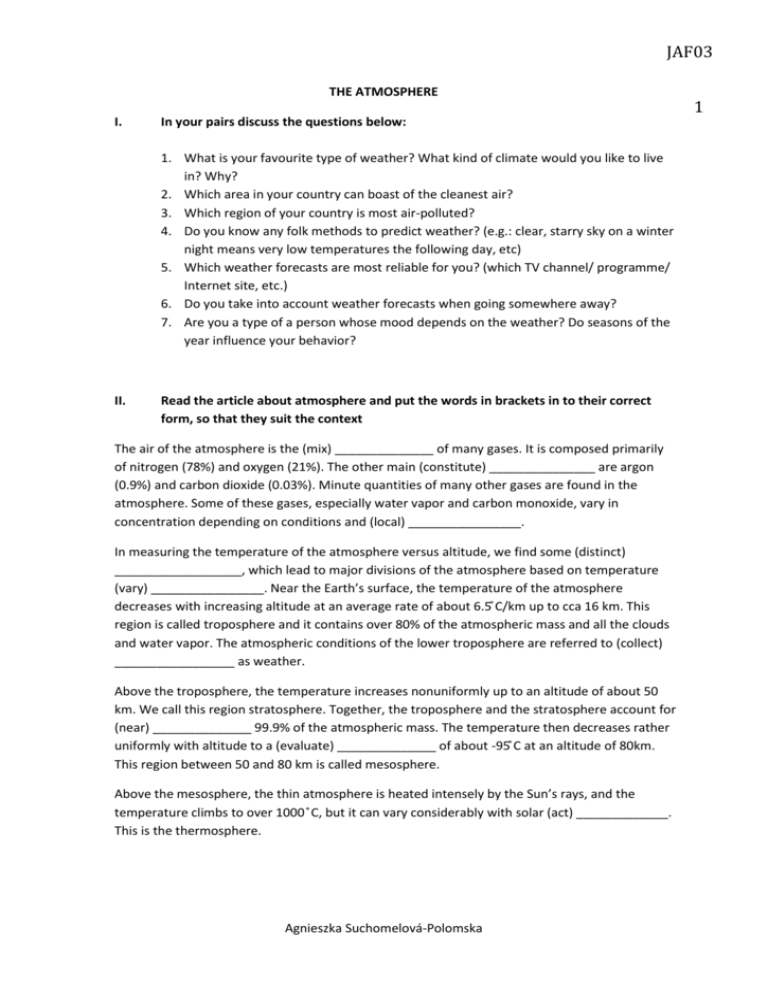
JAF03 THE ATMOSPHERE I. In your pairs discuss the questions below: 1. What is your favourite type of weather? What kind of climate would you like to live in? Why? 2. Which area in your country can boast of the cleanest air? 3. Which region of your country is most air-polluted? 4. Do you know any folk methods to predict weather? (e.g.: clear, starry sky on a winter night means very low temperatures the following day, etc) 5. Which weather forecasts are most reliable for you? (which TV channel/ programme/ Internet site, etc.) 6. Do you take into account weather forecasts when going somewhere away? 7. Are you a type of a person whose mood depends on the weather? Do seasons of the year influence your behavior? II. Read the article about atmosphere and put the words in brackets in to their correct form, so that they suit the context The air of the atmosphere is the (mix) ______________ of many gases. It is composed primarily of nitrogen (78%) and oxygen (21%). The other main (constitute) _______________ are argon (0.9%) and carbon dioxide (0.03%). Minute quantities of many other gases are found in the atmosphere. Some of these gases, especially water vapor and carbon monoxide, vary in concentration depending on conditions and (local) ________________. In measuring the temperature of the atmosphere versus altitude, we find some (distinct) __________________, which lead to major divisions of the atmosphere based on temperature (vary) ________________. Near the Earth’s surface, the temperature of the atmosphere decreases with increasing altitude at an average rate of about 6.5 ̊C/km up to cca 16 km. This region is called troposphere and it contains over 80% of the atmospheric mass and all the clouds and water vapor. The atmospheric conditions of the lower troposphere are referred to (collect) _________________ as weather. Above the troposphere, the temperature increases nonuniformly up to an altitude of about 50 km. We call this region stratosphere. Together, the troposphere and the stratosphere account for (near) ______________ 99.9% of the atmospheric mass. The temperature then decreases rather uniformly with altitude to a (evaluate) ______________ of about -95 ̊C at an altitude of 80km. This region between 50 and 80 km is called mesosphere. Above the mesosphere, the thin atmosphere is heated intensely by the Sun’s rays, and the temperature climbs to over 1000 ̊C, but it can vary considerably with solar (act) _____________. This is the thermosphere. Agnieszka Suchomelová-Polomska 1 JAF03 III. Read the second part of the article. Put the verbs in brackets in their correct form, and add a preposition or an adverbial if needed. The atmosphere may also (divide - word order to be changed) __________________ 2 parts based on regions of concentration of ozone and ions, with the ozone region (lie) _______________ below the ions one. Oxygen is less abundant in higher altitudes, so the production and concentration of ozone (depend) _______________ the appropriate balance of UV radiation and oxygen molecules. The optimum conditions occur at an altitude of about 30 km, where the central concentration of the ozone layer (find) _______________. The region below 70 km (refer) __________________ the ozonosphere. The ozone layer in the stratosphere (act) ______________ an umbrella that shields life from harmful ultraviolet radiation from the Sun, by (absorb) ________________ most of the short wavelengths of this radiation. In the upper atmosphere above the ozonosphere, energetic particles from the Sun cause the ionization of gas molecules. The electrically charged ions and electrons (trap) ________________ the Earth’s magnetic field and form in layers in the upper region of the atmosphere, called the ionosphere. The ionosphere (provide) ____________ global radio communications via reflection of waves from ion layers. Solar disturbances, which produce a shower of incoming energetic particles also (associate – word order to be changed) ___________________ beautiful displays of light in the upper atmosphere of the polar regions, (call) ________________ auroras. IV. Now label the picture with the words given below, according to the information from the two texts. thermosphere, mesosphere, stratosphere, troposphere, ionosphere, ozonosphere, ozone layer, aurora Agnieszka Suchomelová-Polomska 2 JAF03 V. Watch the video and answer the questions (source: www.bbc.com) 1. 2. 3. 4. 5. 6. What kind of clouds noctilucent clouds are? In what circumstances can you see them? Why only then? What are normally highest clouds? How high are they? Why is St. Patrick’s a good place to observe noctilucent clouds? How are they connected with the climate change? Give at least 3 places mentioned in the listening where the radars carrying the clouds around are put. VI. Match the pictures of the clouds with their names VII. Read the text below and fill in the gaps with words/ phrases beneath the passage (there are 3 too many) Cloud types Clouds are formed in Earth's atmosphere when water evaporates from oceans, lakes, ponds, and even streams and rivers; or by 1___________________ over moist areas of Earth's land surface. The vapor rises up into colder areas of the atmosphere due to convective, orographic, or frontal lifting. The water vapor attaches itself to 2_____________________ which could be anything from dust to microscopic particles of salt and debris. Once the vapor has been cooled to 3___________________, the cloud becomes visible. All weatherproducing clouds form in the 4___________________, the lowest major layer of the atmosphere. However very small amounts of water vapor can be found higher up in the stratosphere and mesosphere and may condense into very thin clouds if the air temperatures are sufficiently 5___________________. Tropospheric clouds are divided into physical categories with names based upon Latin root words that indicate 6______________________ and process of formation. Clouds of the cirriform category are generally thin and occur mostly in the form of 7__________________. Two other basic categories are stratiform with clouds that are mostly sheet-like in structure, and cumuliform that appear heaped, rolled, or rippled. Two additional categories 8_______________________ the cumuliform group are stratocumuliform, and cumulonimbiform, often with complex structures that include cirriform tops. The essentials of the modern nomenclature system for tropospheric clouds were proposed by Luke Howard, a British manufacturing chemist and an amateur 9____________________ with broad interests in science, in an 1802 presentation to the Askesian Society. Since 1890, clouds have been classified and illustrated in cloud atlases. Polar stratospheric clouds form at very high 10__________________. They are given the name nacreous due to the mother-of-pearl colors that are typically seen. Polar mesospheric clouds are the highest in the atmosphere and are given the Latin name noctilucent which refers to their illumination during deep twilight. Agnieszka Suchomelová-Polomska 3 JAF03 Altitudes, derived from, speed, evapotranspiration, saturation, chemical composition, cold, troposphere, filaments, meteorologist, condensation nuclei, different from, physical structure, Sources: Wikipedia, the free encyclopedia www.bbc.com Shipman et al, An Introduction to Physical Science (adapted from) Agnieszka Suchomelová-Polomska 4

